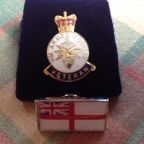-
Posts
5,727 -
Joined
-
Last visited
-
Days Won
2
BEngo last won the day on December 19 2017
BEngo had the most liked content!
Profile Information
-
Gender
Male
-
Location
Charlton Adam
-
Occupation
Retired Consulting Engineer
-
Boat Name
Jarrah
-
Boat Location
Circus Field
Recent Profile Visitors
16,596 profile views
BEngo's Achievements
Veteran II (12/12)
1.1k
Reputation
-
Steel on HDPE or PTFE ( or vice versa) will slide fine. Given that your steel is rusty , and this probably pitted steel sliding on HDPE fixed over the pits is probably easiest. N
-
Disappearance of remanent magnetic field is common, over time. The alternator is designed to self excite, and will do so if used fairly regularly, because that refreshes the rotor magnetism. Leave it for a few months, particularly if it is vibrated, and some or all of the remanant magnetism will have gone. The answer then is to disconnect the regulator and flash a magnetic field into the rotor. Get the connections the right way round! Reassemble and it should ackle as intended. N
-
No problem short term, but the scratches are where it will go when you least want it to. Get a spare, with fitting stuff, and make sure the glass retainer can be got out. N
-
The Ham Baker paddles on the Napton to Knowle section of the GU slope, but not very much. I would guess at 5-10 degrees. N
-

Building a Category C narrowboat!
BEngo replied to dreamboater's topic in Boat Building & Maintenance
I suggest you start by talking to Chris Coburn, Lee Sanitation, if he is still around as he would be in his 80's now, and Wyvern Shipping af Leighton Buzzard. Chris C has been nearly everywhere, including Bude by narrowboat. Boat was Progress. https://www.google.com/url?sa=t&source=web&rct=j&opi=89978449&url=http://www.nb-progress.com/news.html&ved=2ahUKEwj_pbHbw9aFAxVsS0EAHRW5CEUQFnoECBMQAQ&usg=AOvVaw0XvMljgRxV60lImZ7581fS Wyvern shipping huilt Ocean Princess a "seagoing" narrowboat. N -
But uses a lot more elbow grease. N
-

How to chose a new starter battery?
BEngo replied to pedroinlondon's topic in Boat Building & Maintenance
I have always found that a decent makers 243 or 244 size battery, at about 96Ah and 760 or so Cold Cranking Amps will do the biz. Shield make a decent battery at a reasonable price, but Tayna and others on line can also supply I suspect the OP's 3 batteries in parallel are/were the entire outfit of his ex lifeboat so also keep the lights on and work any radio until the motor is running. N -
Ventilation is when air is drawn down from the surface into the propellor, spoiling its thrust. Cavitation is when the pressure at the front face of the propellor blades is low enough for tiny steam bubbles to form ( boiling ) in spots. When the bubbles collapse there is often damage to the propellor, and a lot of underwater noise. Anti ventilation plates as seen on many converted butties e.g. Renown, stop air drawing down and are a substitute for the motors counter plate. Anti cavitation plates do not exist. Cavitation is dealt with by extra immersion and careful propulsion system design N
-
If it is treated battening , across the steel bearers, it will be fine. Battens can be quite thin, so you will need to keep the screws thd eight length, and it is quite narrow, so you may need two pieces next to each other where the floor joins are. Don't forget to put in some access holes for getting at ballast, and to allow for some airflow with the floor down. Having a computer fan behind the fridge, drawing from the bilge area and powered from the fridge electronics, can killl two birds with one stone. N
-
Another source of gas water, though not as common, was the water used as a seal in the old-style rising gasometers. After a period of years in use it was well saturated with gas by-products so could be pumped out and recycled during a planned maintenance period. N
-
If you have a look at the inline filters ( in liskeard) website. Their search widget can be fed the maker and the engine type and it will tell you what filters you need. Assorted variants of the F2L are there. I have always had a quick response to an order, but otherwise no links. Online filters in Stoke on Trent also have a good rep, but I have not used them. N
-

Boat Blacking Recommendations 2024
BEngo replied to Lovemyboat's topic in Boat Building & Maintenance
It is quite possible to get ( the right formulation of) epoxy to adhere to bitumen. Once you have done that the effectiveness of the paint depends on how well the bitumen sticks to the hull. That is at best the same as if bitumen had been carefully applied to the hull. N -
Gas water was also derived from the coke. After it left the ovens the coke was red hot and, in air, would start to burn. So the coke was quenched with water. Some water turned to steam, which, with some coke, might be fed back into the gas producers, but as the coke cooled, there was a lot of water contaminated with products that could be extracted and sold. A Gasworks wasted nothing. N
-
Ensure you have some suitable brushes and contact cleaner for buffing up the contacts in the multi-pin connectors. Halfords Professional line are good quality spanners, not as good as Facom or Snap On perhaps, but guaranteed for life. I twisted the end off a 3/4F to 1/2 in M adapter and it was replaced without a quibble. N
-
As well as those with tanks some C&C boats carried their cargo in (presumably glass) carboys. N










